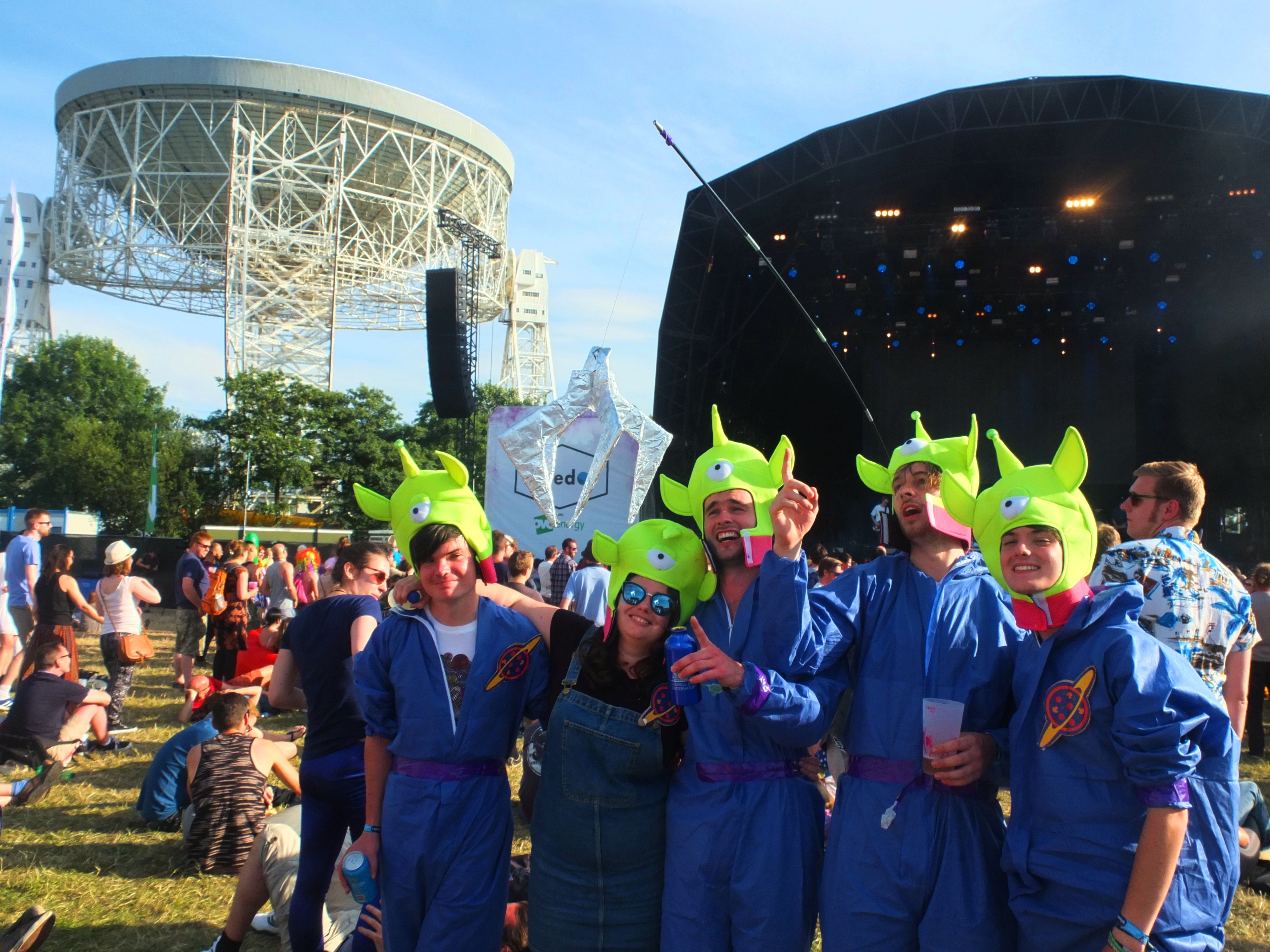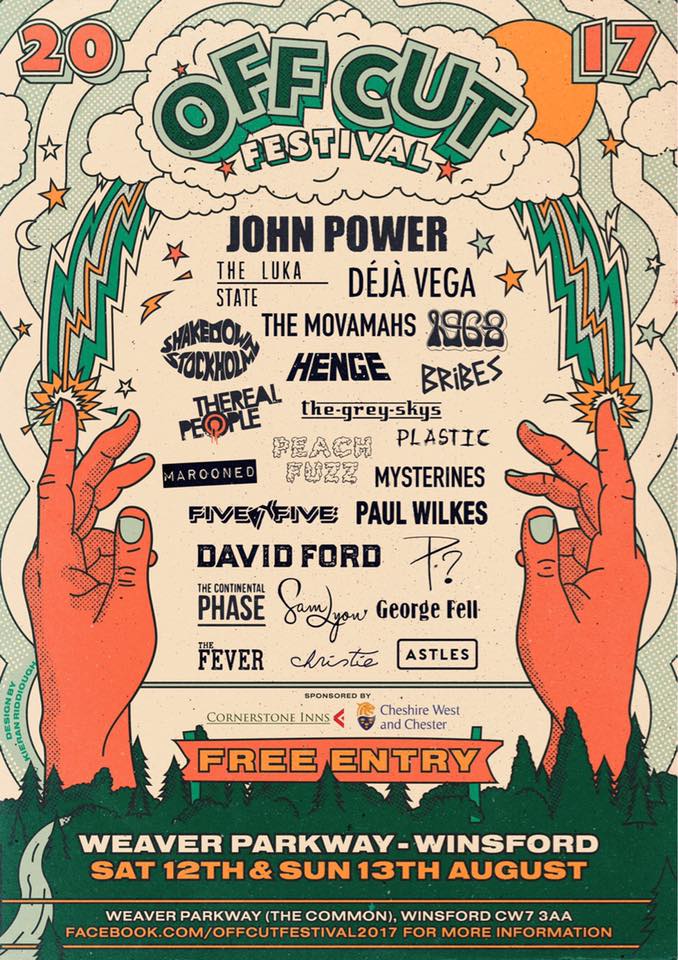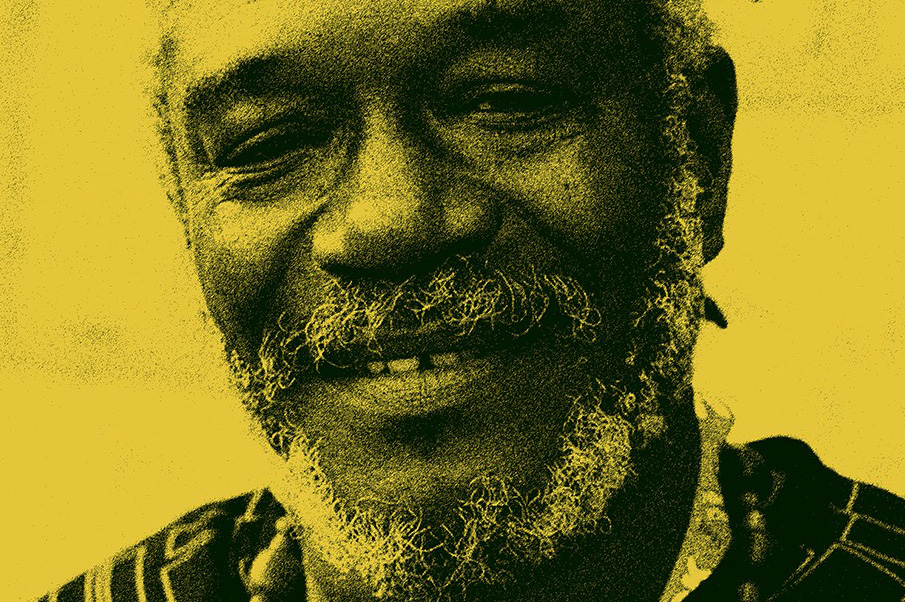
After a successful first mission, Blue Dot landed at Jodrell Bank once again for a stellar programme of music, science, film and technology.
This year marked the 60th birthday of The Lovell Telescope, which stands at the heart of the festival. Projections onto the telescope provided an idyllic backdrop to main stage, which hosted intergalactic headliners Pixies, Orbital and Alt J.
For its modest size, this family-friendly festival was loaded with experiences. There were specially designed science shows for the young and young of heart, pop-up puppet cinemas and even a Jedi Training Academy. Walking into the marquee at the back of the main field I found a replica of the Back to the Future DeLorean, stands full of fascinating science experiments and the opportunity to make your very own Voyager Golden Record (which I of course relished).
Next to the late night bar, there was a play park for the children whilst the adults enjoyed providing an area for picnicking and chilling with a beer whilst the kids played whilst listening to acoustic music on the Roots stage. The festival also afforded kids the chance to dress up as their favourite NASA spaceman. But the adults went to equal efforts with their space outfits.
Much of the music at Blue Dot complemented the space theme mixing experimental rock and electronica. Though, this festival has so much more to offer other than music. You could easily spend an entire day immersing yourself light and colour in the Miracoco’s Luminarium, exploring the 35-acre Arboretum, observing a quick-fire lecture, discovering the night sky in a stargazing session or enjoying a relaxing Gong Bath.
Friday’s musical entertainment started with a bang. The Moonlandingz docked on the mainstage but even they admittedly would rather catch a set from UK house pioneers Leftfield who performed their debut album Leftism is its entirety 22 years after its release at the bizarrely early time of 6pm. I caught the last moments of Ezra Furman with his backing band The Boyfriends who combined doo-wop guitars, sax and fuzz, an artist who only seems to be growing in confidence.
We had the pleasure of seeing one of the best live acts on the planet, Pixies headline the Friday night. Interestingly, their indie anthem Where is my mind? has already been transmitted into space to kick start a broken computer on a Mars lander. So, they were the perfect candidates to be wired into the Jodrell mainframe and beamed out into the cosmos. Fans jumped in the rain to classics such as Gauge Away, Debaser, and Monkey Gone To Heaven, as well as songs from their latest release, Head Carrier and a cover of The Jesus and Mary Chain‘s Head On.

When the sun set over the Lovell Telescope, the festival lit up. The Space Walk Parade illuminated the Star Field with goggled percussionists and pulsar lanterns. Fields were ablaze with solar flare flames and spotlighted trees were glittered with imitation bird song. A colony of eerily tranquil, glowing orbs were attracting much affection from festival goers, who could experience the physicality of sound through listening, touching and hugging. It was the ultimate hippie-trippy, yet totally soothing experience.

On the Saturday, I headed over to the Mission Control stage where I enjoyed amusing talks featuring The Naked Molerat, and humorous tales of biological experiments in space. Coming from a science background, I really appreciated this rare mix of comedy, science and music.
Back on The Orbit stage, the stars of the show were the latest manifestation of Radiophonic Workshop with their universally acclaimed audio visual show. Founded in 1958 by Desmond Briscoe and Daphne Oram, the Radiophonic Workshop was created to put new electronic music techniques at the service of the BBC’s radio and television producers. Today, they were joined onstage by Paul Hartnoll, one half of the electronic dance music duo (and Saturday headliners) Orbital. This performance also carried a special significance coinciding with the 80th anniversary of electronic pioneer and previous member Delia Derbyshire. The collective paid tribute to Delia before playing her original arrangement of the Doctor Who theme for which she was best known. It was clear that the audience weren’t just applauding for the Radiophonic Workshop veterans onstage but all the electronic pioneers that came before them such as Brian Hodgson – creator of the TARDIS sound effect.
Goldfrapp graced the Lovell Stage with her gritty, electropop melodies catering to both the casual pop fan and the underground crowd. But it was Orbital who dominated the evenings entertainment. They donned the stage in their iconic torch-glasses for what was to be the duos third live show since announcing their return earlier this year. The set recaptured the spirit of the 90s with classic dance anthems Chime, Belfast and Halcyon And On and On. Revelers at the Lovell stage truly lost themselves in the music. The set also featured new techno tune also, Cooping Lisa (a working title, apparently), but their new song Kinetic 2017 disappointingly didn’t make the set. The dance verterans again combined forces with Radiophonic Workshop to play the Doctor Who theme. It was a euphoric, entrancing performance that won’t be forgotten with ease.

Burning the midnight oil, I navigated to the Orbit Stage where I witnessed the legendary belgians Soulwax, before concluding the night with Max Cooper presents; Emergence on the Mission Control stage.
On the Sunday afternoon I headed to the Star Pavilion for a Dot Talk on Flashes in the Radio Sky. University of Manchester Astrophysics professor Ben Stappers discussed the concept of Fast Radio Bursts and how using radio pulsars to detect gravitational waves generated by processes such as inflation, cosmic strings and binary supermassive black holes give us a glimpse of the universes’ past. It was completely fascinating.
There were many opportunities to sate a curious mind. A further array of panel sessions and lectures took place on the Contact Stage, mixing some of the most important issues facing our world today with some of the wittiest cosmic culture this side of Alpha Centauri.
Sunday’s musical highlights included The Whyte Horses Experience, whose psychedelic-pop set featured Josefin Ohrn and members of Badly Drawn Boy and The Go! Team, followed by Warpaint who merged their established art rock sound with subtle RnB and pop influences. I decided to forgo the opportunity to see space-rock progenitors Hawkwind for Sunday headliners Alt J. I have no regrets. They treated us to hits from all three albums with a focus on their debut album An Awesome Wave. When the set came to an end Transmission by New Order blasted out across the site, a fitting end to the weekend of astronomical music.
The Lovell telescope was having essential maintenance, so festival goers missed out seeing it turn to face the crowd like last year. However, the worlds of music and science collided with Celestial Frequencies. The flagship artistic commission COSMOS invites artists to transform the telescope into a canvas for audio-visual artwork. Last year saw Brian Eno’s light installation projected onto the 90-metre tall structure. This year was the turn of Tokyo-based Daito Manabe alongside fellow artist Setsuya Kurotaki, who used the raw data from deep space to fuel the projections back onto the telescope. It didn’t stop there, as this data transforms from radio waves to the visible light an audio soundscape is generated creating a fully immersive experience. Blue dot discoverers could even manipulate the observational frequencies themselves, thus altering the data visualisation on the dish. (Watch here)! I sat in awe as this steel behemoth brought a mesmerizing end a magical weekend. I cant wait to discover Bluedot all over again in 2018.

Words and Photos: Rebecca Worthington


